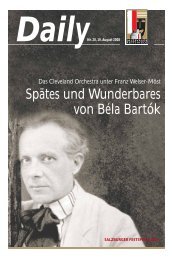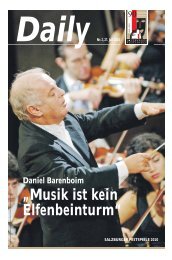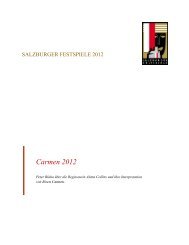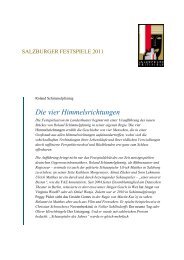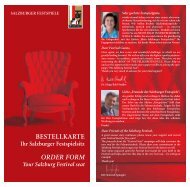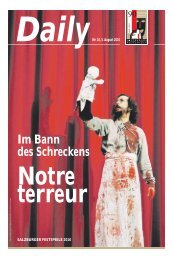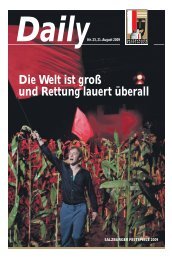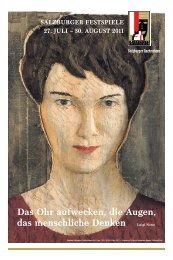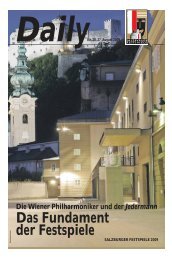Programmfolder Pfingstfestspiele 2013 - Salzburger Festspiele
Programmfolder Pfingstfestspiele 2013 - Salzburger Festspiele
Programmfolder Pfingstfestspiele 2013 - Salzburger Festspiele
Sie wollen auch ein ePaper? Erhöhen Sie die Reichweite Ihrer Titel.
YUMPU macht aus Druck-PDFs automatisch weboptimierte ePaper, die Google liebt.
which still remains one of the most original and impressive stagings of this ballet today.<br />
This wonderful ballet is presented together with other splendid masterpieces from the<br />
heritage of the Ballets Russes.<br />
Since most ancient times, sacrifices always formed the core of religious identity, and a<br />
great sacrifice is of course at the core of the Christian belief as well. The life that Christ<br />
gave to his followers brings them redemption and hope – themes that inspired music<br />
in countless ways. I have chosen contrasting works by Haydn, Jommelli and Brahms<br />
to show how differently musicians have treated those concepts that form the basis of<br />
our Western culture: Haydn in an abstract sound-painting of the last words of Christ,<br />
Jommelli in an impressive, virtually theatrical rendering of the Old Testament story of<br />
Abraham and Isaac. And Brahms in an extremely personal view of the Death of the Lord,<br />
seen as a source of consolation and restoration for our minds, that goes far beyond the<br />
boundaries of a church service.<br />
Of course, there are also other kinds of sacrifices: Bach would have probably felt he<br />
sacrificed part of his artistic integrity when King Frederic the Great put him on trial by<br />
giving him an immensely difficult theme to improvise on – later he called this work<br />
Das Musikalische Opfer.<br />
The word “Opfer” and the term “Offertorium” are in fact derived from the Latin<br />
“offerre”: the offertory, when during church service wine and bread – symbols of Christ’s<br />
sacrifice – are brought to the altar. So when Sofia Gubaidulina wrote her violin concerto<br />
Offertorium and decided to use Bach/King Frederic’s theme as a basis, she carried that<br />
tune across into a spiritual, religious sphere. Amongst others, this work speaks to us<br />
about death and resurrection, but of course no work by Gubaidulina can be thought of<br />
without the implications of the artist as a victim of a political regime. This ties it together<br />
with one of the greatest and most moving works of the 20 th century, which at once pays<br />
homage to the Jewish victims during World War II and at the same time to all people<br />
who suffered and suffer under a dictatorship: Shostakovich’s 13 th Symphony.<br />
re-rite, on the other hand, is a fascinating kind of interactive multi-media exhibition<br />
where you will find yourself inside an orchestra performing Stravinsky’s Rite of Spring.<br />
You may even play a part yourself if you like! I do hope that particularly young people<br />
and children will enjoy this unique musical experience.<br />
And finally we will continue our collaboration with DAS KINO and screen Andrei<br />
Tarkovsky’s last film The Sacrifice, a philosophical rendering of the questions of sacrifice<br />
and redemption and a film from which the images in this programme are taken.<br />
Cecilia Bartoli<br />
3




